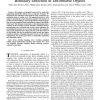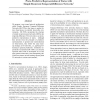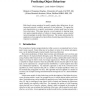48 search results - page 2 / 10 » Predicting future object states using learned affordances |
GIS
2007
ACM
13 years 11 months ago
2007
ACM
As technology advances we encounter more available data on moving objects, thus increasing our ability to mine spatiotemporal data. We can use this data for learning moving object...
TIP
2008
13 years 4 months ago
2008
We propose a principled framework for recursively segmenting deformable objects across a sequence of frames. We demonstrate the usefulness of this method on left ventricular segmen...
ICML
2009
IEEE
14 years 5 months ago
2009
IEEE
We propose a new neural network architecture, called Simple Recurrent Temporal-Difference Networks (SR-TDNs), that learns to predict future observations in partially observable en...
ATAL
2008
Springer
13 years 6 months ago
2008
Springer
Predictive state representations (PSRs) are models that represent the state of a dynamical system as a set of predictions about future events. The existing work with PSRs focuses ...
IVC
2000
13 years 4 months ago
2000
Rule-based systems employed to model complex object behaviours, do not necessarily provide a realistic portrayal of true behaviour. To capture the real characteristics in a specif...



